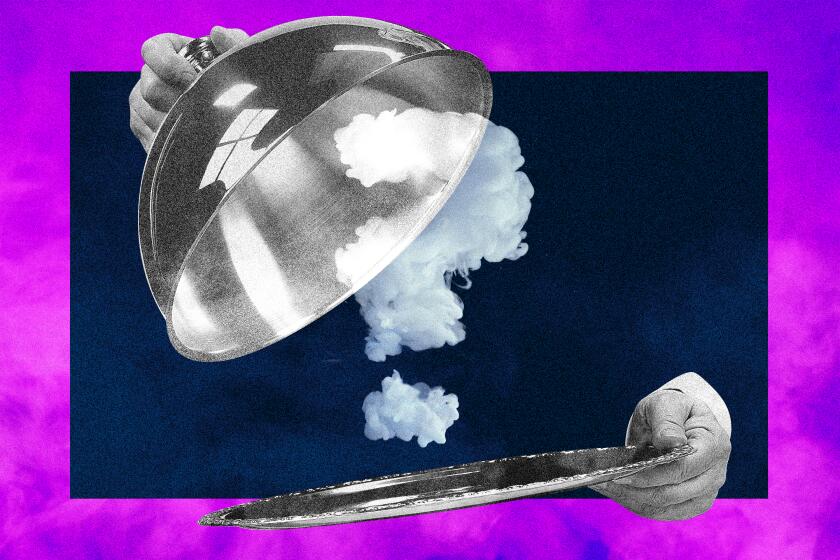A Public Goodbye for Williams
For many of the mourners filing past the casket Monday, the gray-bearded gentleman in the tailored gray suit and silk tie bore little resemblance to the man they remembered as the muscle-bound, fearsome Crips co-founder, Stanley Tookie Williams.
“When I was a kid, Tookie was the most dangerous man in South-Central Los Angeles,” recalled Najee Ali, 42, director of Project Islamic Hope, a Los Angeles-based civil rights group. “Looking at him today, I’m reminded that my childhood has long since passed.
“Many of the people who lined up today for a last look at the man didn’t know him; never met him,” Ali said. “But they came to pay their respects because they have a Tookie in their family, or identify with his struggle.”
Ali was among more than 2,000 people of all ages -- many of them clad in Crips blue -- who gathered at the House of Winston Mortuary on South Vermont Avenue at 95th Street where Williams’ body reposed.
Williams, 51, was put to death by lethal injection Dec. 13. He was convicted of murdering four people, but supporters said he deserved clemency because he had spent his last years trying to steer children away from gang violence.
The public viewing of his body attracted a sometimes rowdy crowd that spilled into the street, backing up traffic. Marijuana smoke wafted through the air as sport utility vehicles with 20-inch rims cruised past, rap music blaring at full volume.
Adding tension to the activities in Williams’ old Crips neighborhood, members of traditional rival Blood gangs took their place in line under the watchful eye of Los Angeles police officers across the street.
When elementary schoolteacher Macella Hibbler, 34, heard that Williams’ body was on public view, she threw sweaters on her three young children and hurried to the mortuary to see the man whose life story had saturated the news media only a week ago.
“My only thought has been this: How can I get my children to understand, I mean really understand, why we’re here?” she said. “I’m telling them, ‘Watch the road you take and make wise decisions. That way you won’t wind up in a coffin.’ ”
On a crowded street corner a few yards away, a group of young men wearing blue jerseys and ball caps flashed gang signs at a passing vehicle, then charged into the street and tossed a bottle at it.
Others handed out posters of Williams behind bars. One boasted out loud to no one in particular: “Thirty-five years ago, who was closest to Tookie? Me. Right here. Me!”
Cedric Mosely, 50, actually was among an inner circle of original Crips who, like Williams, idolized Al Capone, wore a trench coat and black Stetson, walked with a cane and enjoyed watching 1930s-era gangster movies starring Humphrey Bogart and James Cagney.
Stepping outside of the mortuary and into a parking lot where a few dozen former Crips gathered to sip brandy and swap gang war stories, Mosely declined comment except to say, “This is a day of celebration. My brother is free.”
With his friend and editor of 13 years, Barbara Becnel, Williams published 10 children’s books denouncing gangs. Under Becnel’s guidance, Williams, who maintained his innocence to the end, became a global symbol for opponents of the death penalty.
Becnel, who arranged the six-hour public viewing that began at 3 p.m., said she plans to recite Williams’ final wishes -- which he refused to share with San Quentin’s warden before he was executed -- at a memorial service scheduled for noon today at Bethel AME Church in Los Angeles. She said he will be cremated and his ashes scattered in South Africa.
“His story is not ending here,” she said Monday at the viewing.
Standing outside the mortuary, watching the spectacle in the street, Wanda Smith, 42, shook her head and said, “I feel sorry for Tookie. It could have been my own brother, or my son.
“I hope that his death will make gangbangers stop killing each other,” she said. “I’ve been to so many funerals, it’s heartbreaking.”
More to Read
Start your day right
Sign up for Essential California for news, features and recommendations from the L.A. Times and beyond in your inbox six days a week.
You may occasionally receive promotional content from the Los Angeles Times.







